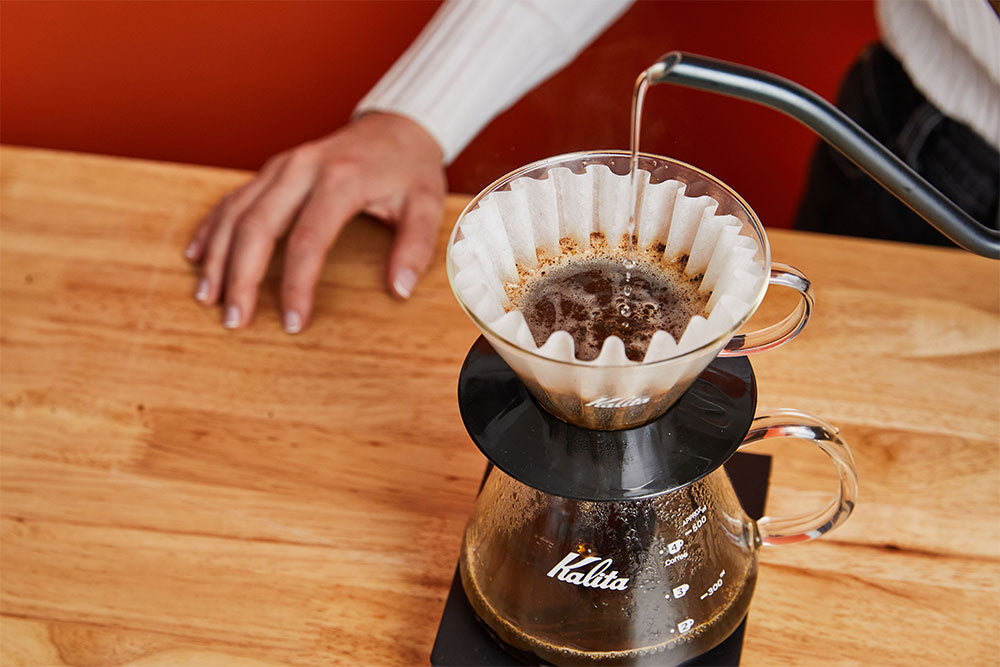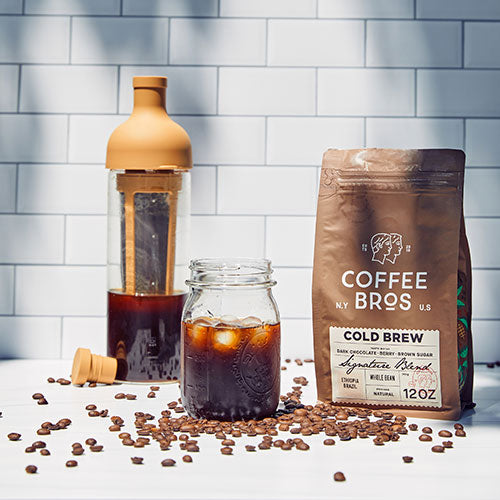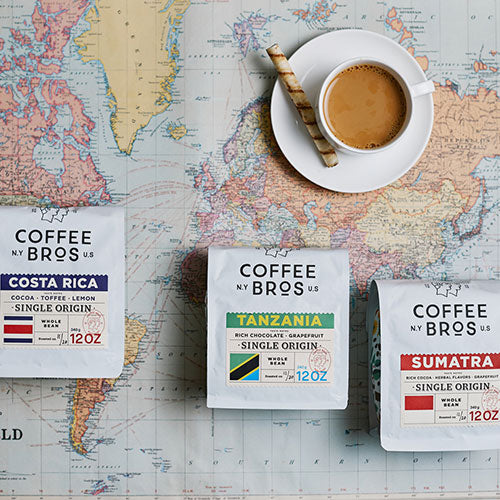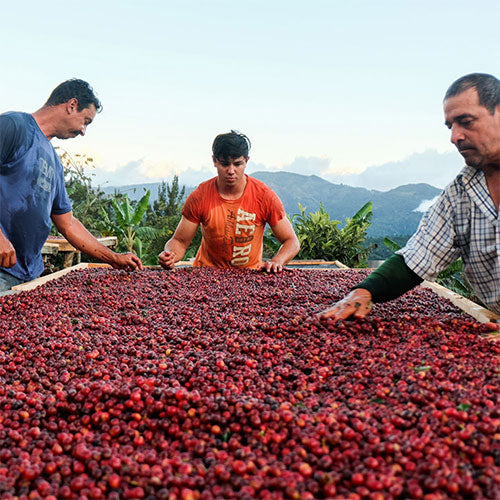Introduction
We are here to demystify coffee brewing as confusion has again set in around drip coffee, its definition, and its relation to filter coffee, pour-overs, and several other manual brewing methods.
Drip coffee is an extremely vague term describing a brewing method, often corresponding to an automatic drip or filter coffee machine. The phrase “I would like a drip coffee” is pretty vague regarding what brewing method or coffee roast level you want. That said, if you walk into any coffee shop in NYC or, quite frankly, anywhere worldwide and ask for a drip coffee, they will most likely give you a coffee brewed out of their automatic filter coffee machine.
But, before we put the nail in the coffin and claim that all requests for drip coffee mean a brewed cup of coffee from an automatic filter machine, let’s break this down a bit further, and here is where we might differ from others on this.
Drip coffee is a brewing method where water drips onto a bed of coffee grounds, draining through a filter (paper or other) and into a carafe or cup.
When you look at the previous statement, you now have many coffee brewing methods that fit that definition. We hope the remaining article will help you spot the differences between each. Then, when you order coffee next, you get slightly more specific on what you are looking for, as each drip coffee method can have drastically different results.
Coffee Subscription Deal
Subscribe to Coffee Bros. coffee for 25% off when using code "FTSUB25" at checkout
Table of Contents
- What is the difference between drip coffee and regular coffee?
- Is filter coffee and drip coffee the same?
- Is drip coffee the same as a pour-over?
- Drip coffee vs. French Press
- How do you make drip coffee?
- What equipment do you need to make a manual drip coffee?
- What equipment do you need to make an automatic drip coffee?
- Summary
Recommended Reading: The Best Espresso Machines of 2024
What is the Difference Between Drip Coffee and Regular Coffee
When walking into a café, most people ask for a regular coffee, usually one that is brewed through a drip or filter coffee machine.
To most, Regular and drip coffee is essentially the same thing, but without getting into specifics, both are coffee brewed by dripping hot water onto a bed of coffee, which then flows through a paper filter. Whether the hot water pouring is done manually (like by hand using a gooseneck kettle for a pour-over) or by a machine, both would be loosely considered a drip or regular coffee.
There are cafes in New York City, one in mind by the name of Abraco Espresso, where if you walk in and ask for a drip coffee, a regular coffee, or even a filter coffee, you will get the same thing: a pour-over coffee using their “drip coffee” blend. Confusing? Well, not to some, as that is the only way they brew drip/regular coffee, as they do so manually and by hand.
Most cafes will reserve the term regular or drip coffee, which usually means an automatic filter brew (through a machine), and use the pour-over or other manual brewing methods for specialty one-of-a-kind offerings.
Is Filter Coffee and Drip Coffee the Same?
In our eyes, they are 100% the same thing. Still, due to differences in how certain cafes define their menu and the use of vague terms when describing coffee and brewing methods, most have defaulted drip and filter coffee to usually mean coffee brewed from an automatic drip/filter machine.
Suppose the above hasn’t confused you already. In that case, do note that coffee brewed through a drip method is simply any in which hot water is poured over a filtered coffee bed, manually or automatically (through a machine). Asking for a filter or drip coffee will usually result in you getting a cup of coffee brewed through an automatic drip machine. However, brewing methods like pour-over (Chemex, V60) are also filter coffee.
Is Drip Coffee the Same as a Pour-Over?
Drip coffee and pour-over coffee are essentially the same thing. If you asked us, “drip coffee” is a vague description of any brewing method involving hot water pouring over a filtered coffee bed.
That said, if you walk into most cafes and ask for a drip coffee, they will give you a cup from their automatic filter/drip machine. That’s why being specific about what you want is always helpful, especially in the café setting.
While nothing is wrong with a cup of coffee from an automatic filter machine, do note that anything automatic has limitations, and most cafes reserve their best coffees for more manual methods like V60 pour-overs and Chemex.
So, while a drip coffee is essentially a pour-over as the brew process is quite similar, note that asking for a drip coffee in most places will default to a cup from an automatic filter machine.
Drip Coffee vs. French Press
If you made it this far into the article, you now know the ins and outs of drip coffee and that it is a brewing method, whether manual or automatic, where water is poured over a bed of filtered coffee grounds.
If you ask for a drip coffee at a café, you’ll likely get an automatic filter brewed coffee; less often than not, it may be a pour-over coffee, but one thing is certain: it will never be a French Press.
The French Press brewing method differs greatly from what is considered a drip coffee. The French Press is an immersion-style glass brewer where coffee grounds are fully immersed in hot water for the duration of the brew, resulting in a rich and full-bodied cup of coffee with a wide range of flavors. The French Press is suitable for most types of coffee, and its ease of use makes it a versatile and user-friendly brewer.
However, the French Press is often criticized for producing a slightly "muddy" cup due to its coarse mesh filter that lets small particles through. The Espro French Press addresses this issue with its ultra-fine and fine micro-mesh filters, which allow for a wider range of grind sizes.
You will find pour-over or automatic drip brews with a cleaner cup that can be brighter or more crisp than a French Press.
Recommended Reading: French Press Brew Guide
How Do You Make Drip Coffee?
If you made it this far, you now know there are several ways of making drip coffee, and what they all have in common is coffee grounds that sit on top of a filter that hot water is poured through.
Knowing the differences between drip or filter coffee methods will allow you to home in on your ideal cup of coffee.
Filter/Drip Coffee Machine:
A filter or drip coffee machine like the Moccamaster allows you to automatically brew a cup of drip coffee through a cone-shaped filter (much like the V60) across varying temperatures of 196 - 205°F.
What is great about automatic filter machines is they take a lot of guesswork out of the extraction phase and can brew a carafe of coffee in 4-6 minutes with little work.
Where automatic machines might prove to underperform manual coffee brewing through the ability to manipulate flow rates, pouring intervals, temperatures (outside of the range of the machine), and blooming (pre-infusion) times.
Pour Over:
To us and many others in the industry, a manual pour-over like one from a V60 or Chemex is the gold standard when brewing coffee. Why is this? Manual brewing allows the home barista to impact all aspects influencing overall extraction quality, including time, temperature, and ratios.
Unlike the easier drip coffee machine, you have full control over temperature, pouring intervals, blooming times, and overall extraction time, whereas most machines have one option or a couple.
This is why some cafes might reserve their “special” coffee for a pour-over, as they can extract it exactly how they like.
What Equipment Do You Need to Make a Manual Drip Coffee?
You have a few options if you want to start manually brewing coffee at home.
1. Budget-friendly: If you choose pre-ground coffee (though not ideal – read here why), a Hario V60, and a basic pour-over gooseneck kettle, all for under $75.00. This initial, more economical setup allows you to enjoy superior coffee to standard automatic drip machines.
2. Advanced setup: A more advanced setup would include a premium grinder and an electric kettle with temperature control. With a setup like this, you can brew café quality pour-overs impacting every aspect of the extraction from time, temperature, grind size, and more.
Whole Bean vs. Pre-ground Coffee
The first decision in your pour-over journey involves choosing between pre-ground coffee and grinding your beans. Our article delves into the advantages of grinding your beans, highlighting why freshly ground beans trump pre-ground options. After exploring the article, the value of a quality grinder becomes apparent.
For those newly venturing into coffee brewing, a dependable conical burr grinder, like the Baratza Encore, priced under $170.00, is an excellent choice. This model is a popular initial grinder among coffee experts before they progress to more advanced grinders that offer finer, more uniform grinds.
Deciding when to invest in a grinder is ultimately a personal decision, but we strongly advise investing early on. We believe it's an essential step for consistently outstanding coffee.
Brewing Device
Various pour-over brewing devices are available, each with unique characteristics and fanbases. However, when balancing quality and cost, the Hario V60 stands out. Below, we outline your choices for pour-over coffee brewers.
Classic pour-over options:
1. Hario V60
2. Kalita Wave
3. Chemex
4. Melitta
New and lesser-known options:
1. April dripper
2. December dripper
3. Origami dripper
4. Fellow Stagg
The differences between these brewers are based on several factors, such as:
Material: The material of the brewer affects temperature stability during the brewing process, which can impact overall extraction. The options above include metal, ceramic, and plastic brewers.
Surprisingly, plastics are excellent insulators, meaning they can efficiently trap heat — a quality advantageous in something like a coffee brewer. -Source: news.mit.edu
Flow rate: The design of the pour-over brewer, whether flatbed or cone-shaped, impacts water flow through the coffee and filter into your mug or server. The shape differences affect coffee-to-water contact, which ultimately impacts flavor quality. Each brewer type requires slightly different grind settings to maximize device performance.
Filter type: Filter types vary based on brewer selection. Flatbed brewer filters have a flat bottom, while cone-shaped filters are, as the name suggests, cone-shaped. Choosing the correct filter is crucial, as the wet filter must make perfect contact with the brewer to ensure a consistent shape that impacts flow and extraction. Manufacturers offer filters with different thicknesses to affect further flow rate, which is useful when brewing different roast types (light, medium, or dark).
What Equipment Do You Need to Make a Manual Drip Coffee?
If you are looking for ultimate convenience but still looking for a solid cup of drip coffee, an automatic filter machine is what you should be looking for.
Like the pour-over method, you can come in even more inexpensive and default to pre-ground coffee (again, not recommended due to the reasons here) or purchase yourself a mid-range conical burr grinder to even more out of your brewing experience.
There are a few solid options on the market for drip coffee, and we always push consumers toward the Moccamaster as they are quite efficient and brew very similarly to a pour-over coffee.
Some things that we love about the Moccamaster are:
1. Handmade in the Netherlands
2. Copper internal components and not plastic
3. BPA Free
4. Temperature control between 196 - 205°F
5. V60-like cone-shaped brew basket
Summary
We hope by the end of this article, you leave some great information concerning the differences (or not many differences) between drip coffee and other filter brewing methods. Note that simplicity in ordering has left the drip coffee request to mean a coffee typically brewed through a machine. Higher-end and special coffees are usually reserved for more manual drip/filter methods like the pour-over.
If you are ever looking for assistance in brewing a pour-over, Chemex, French Press, or any other brewing method, look at our coffee brew guides here.
As always, let us know your thoughts, and we hope we were able to further clarify what drip coffee truly is.




